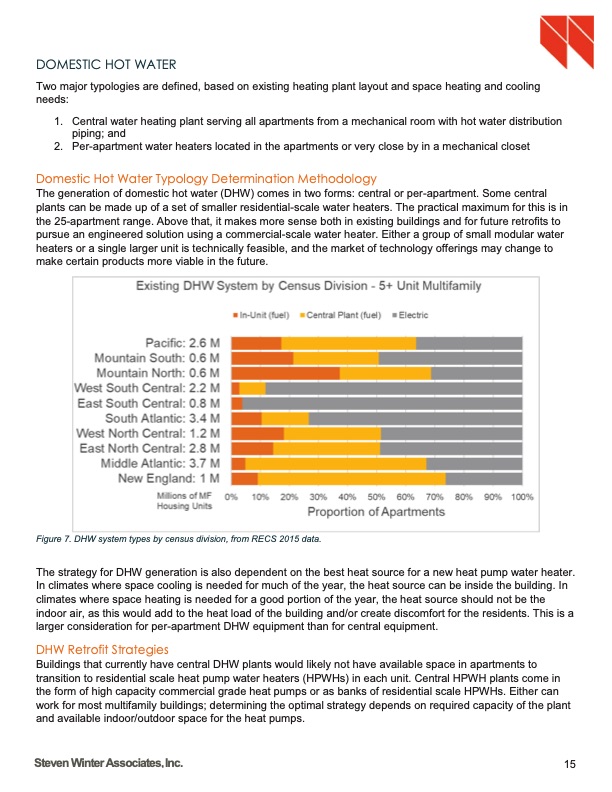
PDF Publication Title:
Text from PDF Page: 015
DOMESTIC HOT WATER Two major typologies are defined, based on existing heating plant layout and space heating and cooling needs: 1. Central water heating plant serving all apartments from a mechanical room with hot water distribution piping; and 2. Per-apartment water heaters located in the apartments or very close by in a mechanical closet Domestic Hot Water Typology Determination Methodology The generation of domestic hot water (DHW) comes in two forms: central or per-apartment. Some central plants can be made up of a set of smaller residential-scale water heaters. The practical maximum for this is in the 25-apartment range. Above that, it makes more sense both in existing buildings and for future retrofits to pursue an engineered solution using a commercial-scale water heater. Either a group of small modular water heaters or a single larger unit is technically feasible, and the market of technology offerings may change to make certain products more viable in the future. Figure 7. DHW system types by census division, from RECS 2015 data. The strategy for DHW generation is also dependent on the best heat source for a new heat pump water heater. In climates where space cooling is needed for much of the year, the heat source can be inside the building. In climates where space heating is needed for a good portion of the year, the heat source should not be the indoor air, as this would add to the heat load of the building and/or create discomfort for the residents. This is a larger consideration for per-apartment DHW equipment than for central equipment. DHW Retrofit Strategies Buildings that currently have central DHW plants would likely not have available space in apartments to transition to residential scale heat pump water heaters (HPWHs) in each unit. Central HPWH plants come in the form of high capacity commercial grade heat pumps or as banks of residential scale HPWHs. Either can work for most multifamily buildings; determining the optimal strategy depends on required capacity of the plant and available indoor/outdoor space for the heat pumps. Steven Winter Associates,Inc. 15PDF Image | HEAT PUMP RETROFIT STRATEGIES FOR MULTIFAMILY BUILDINGS

PDF Search Title:
HEAT PUMP RETROFIT STRATEGIES FOR MULTIFAMILY BUILDINGSOriginal File Name Searched:
heat-pump-retrofit-strategies-report-05082019.pdfDIY PDF Search: Google It | Yahoo | Bing
CO2 Organic Rankine Cycle Experimenter Platform The supercritical CO2 phase change system is both a heat pump and organic rankine cycle which can be used for those purposes and as a supercritical extractor for advanced subcritical and supercritical extraction technology. Uses include producing nanoparticles, precious metal CO2 extraction, lithium battery recycling, and other applications... More Info
Heat Pumps CO2 ORC Heat Pump System Platform More Info
| CONTACT TEL: 608-238-6001 Email: greg@infinityturbine.com | RSS | AMP |